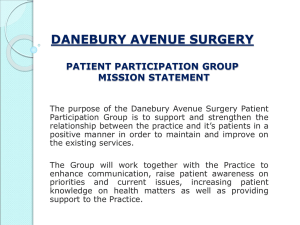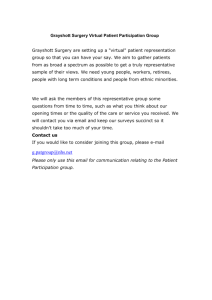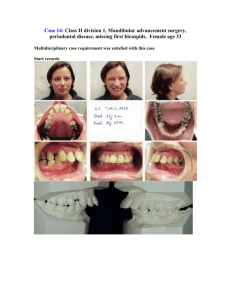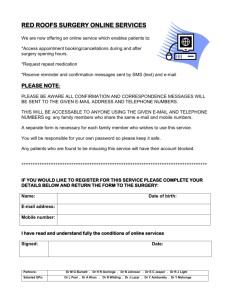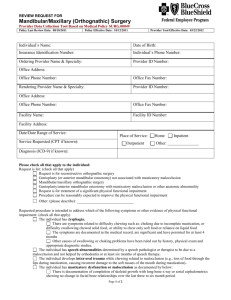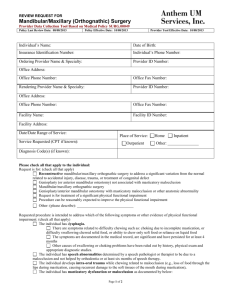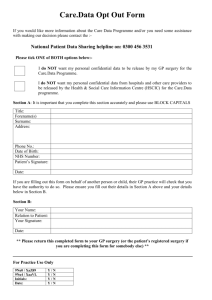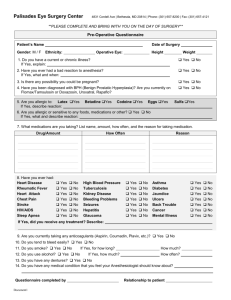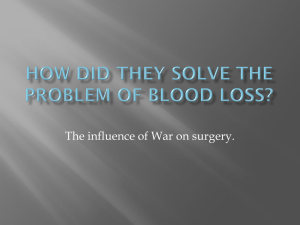types of surgical-orthodontic treatment
advertisement
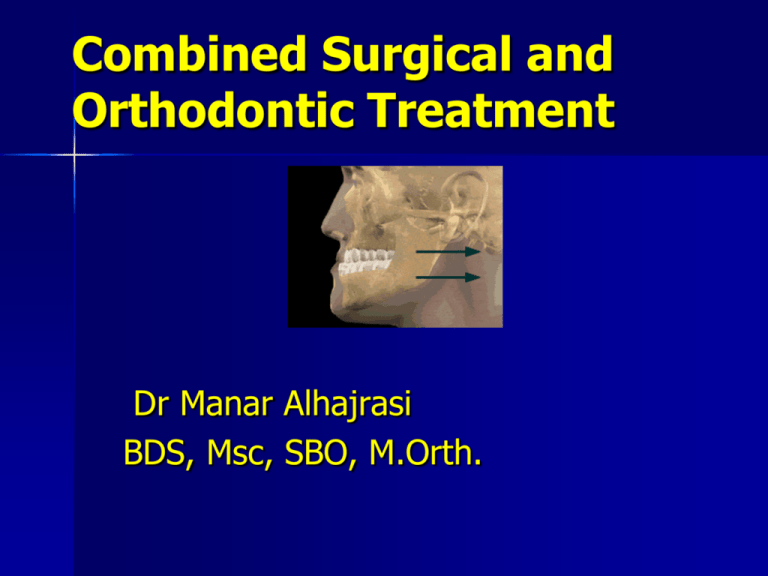
Combined Surgical and
Orthodontic Treatment
Dr Manar Alhajrasi
BDS, Msc, SBO, M.Orth.
Orthognathic surgery
Orthognathic surgery refers to the surgical
repositioning of the maxilla, mandible, and
the dentoalveolar segments to achieve
facial and occlusal balance.
One or more segments of the jaw(s) can
be simultaneously repositioned to treat
various types of malocclusions and jaw
deformities.
Indications for Surgery
Severity of the skeletal malrelationship (the
envelop of discrepancy).
Esthetic and psychological considerations.
Psychological reactions to Orthognathic
surgery.
Development of
Orthognathic Surgery
:1920
1959:
(Trauner
Setback
1960’s:
(Europe)
1980’s:
1990’s:
Mandibular Setback for Mandibular
Prognathism
Sagittal Split Ramus Osteotomy
& Obwegeser) for Mandibular
and Advancement
Le Fort I maxillary do fracture
technique for Maxillary repositioning
(modified by: Bell, Epker, Wolford )
Progress in Oral & Maxillofacial
Surgery
Rigid internal fixation replaced
bimaxillary fixation
What makes a problem too severe
for orthodontics alone?
Presence of a severe skeletal
problem.
Age of the patient has past
growth modification
Limitations of orthodontic tooth
movement (e.g. severe intrusion
in the presence of crossbite,
deep/open bites, severe
protrusion)
Severity of the skeletal
malrelationship
The envelop of
Discrepancy
– It shows the amount of
change that could be
produced by orthodontic
tooth movement (inner
envelop); orthodontic
tooth movement +
growth modification (the
middle envelop); and
orthognathic surgery
(the outer envelop).
Esthetic and psychological
considerations
75 %-80% of individuals referred for
orthognathic surgery seek esthetic improvement.
Changes in the position of the nose and chin
have a greater impact on facial esthetics than
changes limited to the lips.
Be careful in understanding patient’s main
concern.
Do not over or under express problems not
addressed by the patient/relative
Psychological reactions to
Orthog.
surgery
90% of patients undergo
Orthognathic surgery report
satisfaction with the result.
Negatives of orthognathic surgery
are:
– Few patients have difficulty in
adapting to the significant
changes in their appearance
– A post surgery period of
psychological adjustment must be
expected.
Patient education and
communication is very important
(Treatment conference) to
prepare the pt. for surgery.
Sometimes, patients did not
accept the obtained results
Consent form should be obtained
before orthodontic or surgical
intervention.
There are only three possible treatment
ways to treat a jaw discrepancy problem
1. Modification of growth
2. Camouflage ( dental compensation
for a skeletal problem )
3. Surgical repositioning of the jaws
and/or dentoalveolar segments
Surgical Procedures and
Treatment Possibilities
Correction of anteroposterior
relationships
Correction of vertical relationships
Correction of transverse
relationships
Correction of Anteroposterior
Relationships
I. Maxillary Surgery:
Maxillary advancement
Down fracture
Technique
Correction of Anteroposterior
Relationships
Maxillary retraction:
Down fracture
technique: limited by
the anatomic
structure immediately
distal to the
pterygomaxillary
fissure.
Retraction of anterior
segment by a
segmental osteotomy
after (extraction
of 2 first premolars).
Protraction of Maxillay
Correction Of Anteroposterior
Relationships:
Mandibular Surgery
Mandibular
Advancement:
1. Bilateral Sagittal
Split Osteotomy (BSSO)
of the mandibular
ramus
Mandibular
Advancement
Correction Of Anteroposterior
Relationships
Bilateral sagital split osteotomy
has the following advantages:
Intra oral approach
Broad interface of medullar (Rapid
healing)
Easy fixation by intra osseous
wiring
Rigid internal fixation (RIF) with
bone screws
Bilateral Sagittal Split Osteotomy
( BSSO ) drawbacks
Reduced interincisal opening
postoperatively
Altered sensation in the lingual
nerve distribution ( transient
2 - 6 months ).
Paresthesia over the distribution
of the inferior alveolar nerve.
Correction Of Anteroposterior
Relationships
Mandibular Setback:
1. Bilateral Sagittal Split
Osteotomy
(BSSO)
Excellent control of the
condylar segment.
Osteosynthetic screws can be
employed for fixation.
Mandibular set back:
(cont’d.)
.2The Trans Oral Vertical Oblique
ramus osteotomy (TORVO)
(limited to the reduction of
mandibular prognathism.)
Full thickness overlapping segments
Less likely to produce neurosensory changes
Jaw immobilization is necessary
Difficult control of the condyles
Correction Of Vertical Relationships
Maxillary Surgery:
Correction of skeletal open bite
(long face) deformity by:
Le Fort I down fracture of the maxilla with
superior repositioning of the maxilla (maxillary
impaction) after removal of bone from the lateral
wall of the nose, sinus and nasal septum.
Correction of Skeletal Open Bite
(cont’d.)
The overall facial height is shortened as
the mandible responds by rotating
upward and forward, altering both its
occlusal and postural positions.
( autorotation )
Excellent stability post surgically.
Sliding genioplasty is needed in case of
deficient chin.
Correction Of Sleletal Open Bite
(cont’d.)
Long- face problems are best treated by
intrusion of the maxilla leading to
Mandibular rotation around the
(autorotation)
condyle
Reduction of mandibular plane angle
Shortening of the face
Closure of the open bite
Correction of Skeletal Open Bite
Correction Of The Vertical Relationships
(cont’d.)
Mandibular Surgery
1. Surgery to reduce mandibular plane angle
and close the open bite by rotating the
mandible down posteriorly and up anteriorly
is highly unstable due to:
a. Lengthening the ramus and stretching
the muscles of the pterygomandibular
sling
b. Lack of neuromuscular adaptation in
these powerful muscles.
Vertical maxillary excess
Vertical maxillary excess
Correction of Vertical Relationships
(cont’d.)
“Skeletal deep bite” or patients with a
“short face” problem (seen in Cl. II div.2
cases) are characterized by a long
mandibular ramus, square gonial angle,
and short nose-chin distance.
Best treated by Sagittal Split
Mandibular Ramus Surgery to rotate the
mandible slightly forward downward after
orthodontic leveling of the lower arch.
Correction Of Vertical Relationships
Short - face problems are best
treated by mandibular ramus surgery
that allows the mandible to move
downward only at the chin.
This will lead to:
increase in the mandibular plane
angle
by shortening of the ramus
opening of the gonial angle
Short Face Problems Treated by
Maxillary Surgery
Le Fort I down fracture of the maxilla to
increase face height is not stable,
therefore not used.
The use of synthetic hydroxylapatite
and simulataneous osteotomy of
the mandible increases stability.
Correction Of Transverse
Relationships
Expansion & narrowing of the dental
arches
It is possible to move the maxillary
segments both away from and toward
the midline with relative ease and
stability.
Correction Of Transverse
Relationships ( cont’d. )
Rapid palatal expansion
Not feasible in adults, because
of the increasing resistance of
the midpalatal & lateral maxillary
sutures.
Correction Of Transverse Relationships
Surgically-assisted palatal expansion
1.
2.
3.
to reduce the resistance of the
segments include:
lateral antral wall. Mid
palatal corticotomy.
Corticotomies in the midline or
Two para-midline vertical cuts
Correction Of Transverse
Relationships (cont’d)
3. Could be done under local anesthesia
4. The jackscrew ( RPE ) is cemented
before the surgery.
5. Activated after the bone cuts are
made to continue for 10 -14 days
followed by a period of stabilization.
Correction of Transverse
Relationship
Expansion and narrowing of
the dental arches
constriction of the
maxilla when it coexist with
vertical and sagittal
problems
Done in the course of the
Le Fort I down fracture,
(segmenting the maxilla)
Asymmetry
Mandibular asymmetry often leads
to a secondary maxillary deformity
ex: More vertical mandibular growth
produces:
compensatory changes in maxillary
growth
tilt of the occlusal plane
Asymmetry
Mandibular deviation also leads to
compensatory changes in the mandibular
alveolar process and the chin deviates more than the
dental midline.
Surgical correction of asymmetry often requires a
Le Fort I osteotomy + BSSO for Mandibular ramus
correction.
Repositioning the chin may also be needed.
GENIOPLASTY
Is an osteotomy to free
a wedge-shaped
portion of the
symphysis and
inferior border that
remains pedicled on
the genioglossus and
geniohyoid muscles.
GENIOPLASTY
This segment can be:
Advanced (advancement
genioplasty).
Moved backward (reduction
genioplasty).
Shifted sideways to correct
asymmetry.
Down-grafted to increase lower face
height.
By splitting the segment vertically,
the wedge can be flared or
compressed.
GENIOPLASTY
The chin can be augmented (in all three
planes of space ) by using:
1. An implant material such as porous
hydroxylapatite, ( not silicone).
2. An osteotomy to reposition
the symphysis, is better than
cutting a wedge of bone.
Limitations Of
Orthodontic Treatment:
Both dental and orthopedic approaches to
attain ideal occlusion through
orthodontic appliances alone may be
unsuccessful.
1.
Skeletal deformity may be too great.
2.
Completion of jaw growth may limit
the amount of orthodontic treatment
possible.
Limitations of Orthodontic Treatment
3. Patient may refuse to wear orthodontic
appliances.
4. Loss of posterior teeth may limit
available anchorage.
5. Some orthodontic movement are
difficult or impossible (significant
intrusion).
6. Esthetic consideration (gummy smile).
7. Economic consideration.
Limitations Of Surgical Treatment:
Surgery alone is not enough and may
be unsuccessful due to:
1.
2.
3.
Teeth need to be properly aligned.
Arch forms must be compatible.
Dental compensations should be
eliminated, so that teeth are well
related with respect to individual jaws.
Timing and Sequencing of
Surgical Treatment
General rules:
Early jaw surgery has little inhibitory
effect on further growth.
Orthognathic surgery should be
delayed until growth is completed.
Orthognathic surgery can be considered
earlier in growth deficiencies
TIMING OF TREATMENT
1.
Actively growing patients with mandibular
prognathism can be expected to outgrow
their correction. “Pelapse`’
2. Psychosocial problems may justify early
surgery to correct prognathism, however
retreatment may be needed
3. The Hand-wrist films to determine bone age
are not accurate for planning the exact
Timing of Surgery.
TIMING OF TREATMENT
4.
5.
The best method is serial cephalometric
tracings, until good documentations that
the adult deceleration of growth has
occurred.
Long Face (skeletal open bite) patients
due to vertical maxillary excess, are
reported to continue to develop vertically
after surgery that was done between 1019 years. Long term follow-up of these
patients are needed.
Sequence of an
Orthodontic/Surgical Plan
I. Sequence:
1. Orthodontics to correct alignment
and inclinations of teeth (no attempt
for skeletal correction.)
Note: Malocclusion may temporarily
look worse.
2. Surgery to reposition the jaws.
3. Finishing Orthodontics.
Objectives Of Pre-Surgical Orthodontics
.1Place teeth in their proper
relationships to mandible or maxilla.
i.e. decompensation of teeth
2. Level both arches independently:
It is sometimes necessary to level
teeth in segments, independently.
3. Align the teeth within the arches.
ex. Lower segmental osteotomy
(Independent leveling)
Pre Surgical Orthodontic
Objectives
To level and align the arches and make
them compatible
to resolve crowding and/or spacing
to establish anteroposterior and vertical
position of incisors (decompensate)
to place teeth relative to their own
supporting bone
Pre-Treatment Evaluation:
Records Needed:
1. Dental casts
2. Dental radiographs
3. Facial photographs (frontal and
profile)
4. Cephalometric radiographs
Check List for Treatment
Planning
A-P relationships
amount of deficiency
Vertical relationships
{
maxillary deficiency/protrusion
mand prognathism/deficiency
open bite
deep bite
Transverse relationships crossbites
before surgery
expansion
surgically assisted expansion
during surgery
TREATMENT PLANNING:
.1Start with problem list determined
from analyzing records and
patients examination.
2. Determine upper incisors and lip
position by cephalometric analysis.
(Surgical prediction cephalometric
tracing)
Treatment Planning.… (cont’d.)
.3Eliminate dental compensation
(i.e. backward orthodontics )
a. In orthodontic approach only the
disharmony is camouflaged.
b. In orthodontic / surgical approach,
the disharmony is accentuated by
decompensating the teeth, to place
the teeth in their proper inclinations
with respect to each jaw independently.
Treatment Planning…
(cont’d.)
.4Determine where to reposition the
jaws.Work toward average facial
proportions for the appropriate ethnic
or racial groups.
i.e.
(Chinese, Blacks, Mexicans, Americans)
5. Predict the soft tissue relationships &
analyze to predict & insure pleasing
results.
Treatment Planning…
(cont’d.)
.6Consult with patient regarding
anticipating changes and patient
expectations.
7. Make decisions for orthodontics or
surgery combined treatment before
starting any treatment.
Mounting of the maxillary
model
Models with completed skeletal
and dental reference lines
Model (Mock) surgery
The splint:
A acrylic splint is made in the laboratory to
transfer the model relationship to the patient
during surgery
Orthognathic surgery
